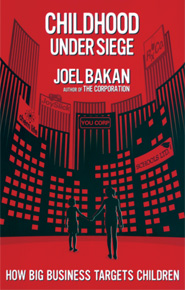How Big Business Targets Chıldren

Joel Bakan. Toronto, ON: Allen Lane Canada, 2011; 277 pp; ISBN: 978-0-67006-907-1, cloth $32 CAD.
Reviewed by Judy Haiven
In Childhood Under Siege, author Joel Bakan digs deeply into childhood in the U.S. and Canada and comes up with staggering facts and figures. He starts with the premise that society pretends to value children by passing laws to protect them from sexual predators, to nurture and educate them. However our society is also quick to push protections aside when it seeks to maximize the “economic value” of children. (p. 163)
Every chapter of this book focuses on an aspect of the devaluation of childhood and children. The first chapter touches on the plight of children in the early 20th century, dubbed “the century of the child” by one author in 1900. In 1959, when the United Nations passed its Declaration of the Rights of the Child, governments — especially in the developed world — were “on the hook” for protecting children from violence, safeguarding their well-being, providing free education and ending child labour. (p. 8)
But by the 1970s, when western leaders such as British Prime Minister Margaret Thatcher raised the cry for ‘individual freedom,’ a neoliberal economic agenda began to unravel many social programs, and undermine children’s welfare. (p. 9) Bakan, who is also the author of the celebrated book The Corporation, insists that since corporations have beaten back and diminished the role of government, children of the 21st century have been rendered more vulnerable today than half a century ago.
According to Bakan, television — what parents in the 1970s and 1980s jokingly called the “electronic babysitter” — has morphed into something more sinister. Seven out of 10 teens in the U.S. have televisions in their bedrooms, along with video game consoles, computers, internet connections and cell phones. “With another hour per day spent texting and talking on cell phones, tweens and teens are engaged with media each day, on average, for nearly twice as long as they attend school. Only two hours (Bakan’s emphasis) a day remains when they are not on media, at school or asleep.” (p. 53)
Violence on television, social media and video games has become mainstream entertainment for children of all ages. While the jury is still out on the effects on young people of watching and virtually engaging in violence through gaming, hundreds of studies over the past 40 years prove high exposure to violence can inure youth to real violence and increase aggressive behaviour and thoughts. (p. 42)
And Bakan sees the marketing industry as a major problem. The packaging of TV shows, with merchandise and video games often reinforces violent themes. Not only is violence seen as fun, glamorous and ‘cool,’ but also as an efficient way to solve disputes. He is also alarmed by media sexualization of girls. He cites the marketing of lace lingerie, padded bras and thong underwear “with Playboy logos, or sexual messages such as ‘too many boys, too little time’,” to girls as young as Kindergarten age. (p. 43) He agrees with experts who oppose a sexualized environment for kids, an environment which objectifies women and sometimes links sex to hurting others.
More and more of childhood is being subverted through marketing, which poses difficult questions for the raising of the next generation. Bakan tips his hat to psychologist Tim Kasser who points out: “To be a consumer has a very different set of implications than to be a citizen.” (p. 45)
But perhaps the most astonishing chapters are about the marketing of pharmaceutical drugs to doctors and parents, and big-pharma’s push to prescribe psychotropic drugs to children. Bakan writes about the case of preschooler, Rebecca Riley, who was found dead at home, lying on her stuffed bear. A child psychiatrist had prescribed clonidine and two other drugs because the four-year-old was hyperactive and having trouble sleeping.
“On the night Rebecca died, her father had directed Carolyn … (the mother) to increase her dose of clonidine in order to suppress a cough … the father would often tell Carolyn to give Rebecca and her siblings more ‘happy medicine’ or ‘sleep medicine’ as they called clonidine, to quiet them down when they were ‘acting up.’ Under the influence of these drugs, Rebecca often slept through the day, getting up only to eat.” (p. 68)
Bakan examines the role of psychotropic drugs in controlling children. It is not a pretty picture. He then takes aim at the all too common diagnosis of Attention Deficit and Hyperactivity Disorder (ADHD) and the attendant Ritalin prescriptions mainly for rowdy, or non-attentive, school boys. He reveals that diagnoses of this disorder in the U.S. between 1980 and 1990 “jumped from 400,000 to 900,000 and the frequency of treatment with drugs from 28 per cent to 86 per cent.” (p. 73)
The author lays much of the blame at the feet of the pharmaceutical companies that want to open new markets, and professionals who see exhausted parents trying to control demanding or moody children.
Bakan’s book is based almost entirely on U.S. statistics and examples and is clearly geared to American readers. While the chapter that looks at environmental degradation and its impact on children’s health begins with an assessment of the Sydney tarponds in Cape Breton, Nova Scotia, the rest of the book tends to conflate the U.S. with Canada. This is a bit strange considering Bakan is law professor at the University of British Columbia and lives in Vancouver. Still the book is worthwhile, but I wouldn’t recommend it for bedtime reading.
---------------------------------------------------------------
Judy Haiven is an associate professor in the management department at Saint Mary’s University in Halifax, Nova Scotia.